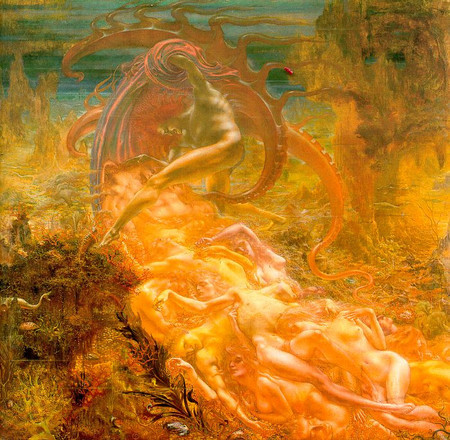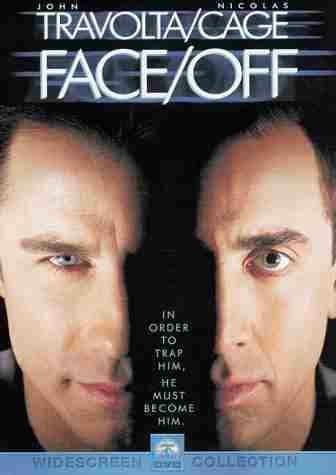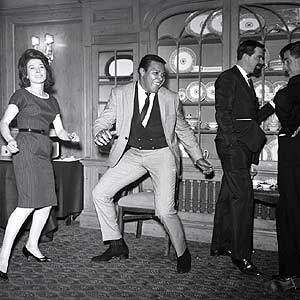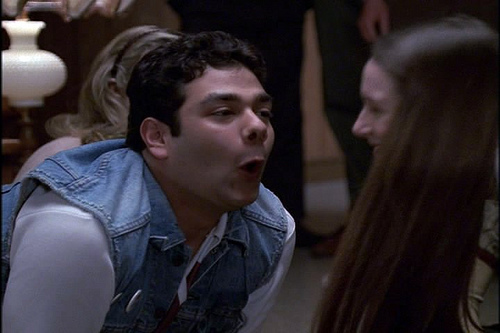

People Person -- As the lead NHL® 09 Profile complete an OTP game with 10 players (Acquired 9/28/2008)
It took me over two weeks to get that achievement; and it didn't take me that long due to a lack of effort. Rather, it was because of the generation of "my way or the highway" players who populate the EASHL community lobbies.
In other words, people who:
A) Bail out of lobbies because they are so impatient that they can’t wait 30 seconds for a 4 vs. 4 game to fill up and become a 6 vs. 6 game
B) Back out of games if they don’t get to play "their position"
C) Exit out of games the moment their team falls behind by two or more goals
D) All of the Above
Should you meet one (or more) of the above criterion, I’d like to remind you that you are not the only player seeking enjoyment from these community games, and honestly, your selfishness is a large part of what’s destroying the fun for the teammates whom you’re leaving to drown in your wake.

Should you wish to make the EASHL community experience more fun for everyone, here are some hints for how you can improve your performance at "your position."
Who knows, you may even discover some exciting new tricks about the positions that you've turned your nose up against in the past.
Centers
Recommended player style:
1) Playmaker (great passer, dominates face-offs, can shoot well with stat boosts)
2) Dangler (good passer, most athletic player-type in the game, can play center effectively if all defensive points go into the face-off stat, poor shooter even with stat boosts)
As a service to everyone else on your team, please do not play center if you cannot win at least 50 percent of your face-offs. Reason being, it is no coincidence that teams who lose the face-off battle often lose the game, too. As for how to win face-offs, remember that it is just as much a battle of player ratings as it is a battle of player skill.
When thinking about the ratings, realize that playmakers are at a serious advantage in the face-off circle, because they start with a default face-off rating of 80, not 75, like all the other forwards.
Regardless of how good your initial face-off rating is, you will still want to spend the majority of your attribute points in the face-off category, because winning the battle in the face-off circle is the most important aspect of playing the center position well.
As for how to win the face-off with your skills, it is really something that must be "felt out," due to the varying latency of each game. But in general, you want to start your poke -- which defaults to "down" on the right joystick for both consoles -- a half-second before the referee sticks his arm out to drop the puck.
In other words, anticipate the ref’s drop, and try to start your poke just before he begins his drop animation.
Also keep an eye on your opponent’s stick before the drop, and remember that you can "play it safe" by waiting and reacting to the ref’s drop, (instead of trying to anticipate the drop) if you see that your opponent is way out in front and left out of position after his initial swipe.

Yes, the center -- or centre, if you’re one of those funny-talking people who always seems to play as Montreal -- is where you should be spending most of your time on the ice.
On offense, when attempting to break into the offensive zone, centers should be looking for open space in the middle of the ice where they can sit, receive a pass, advance the puck up the ice as far as possible, and -- once their Spider Sense starts tingling -- make a quick dish out to a winger filling the outside lane.
Upon entering the zone, centers should continue looking for open space in the middle of the defense where they can collect a centering pass for a quick wrist shot out of the slot.
To make themselves even more effective when patrolling the interior of the ice, centers will want to hold down the "vision control" button whenever they are moving without the puck –- this defaults to the left trigger, for Xbox 360 users.
What "vision control" does, is keep your player’s shoulders square to the puck at all times. The effect this has, is that it keeps your player in good position to pass or shoot the second the puck touches his stick by eliminating the time-consuming twists and turnarounds that your player often has to go through to get a pass/shot off when he’s not locked on to the puck.
Wingers
Recommended player style:
1) Sniper/Dangler (just ask yourself: are you Russ Tyler or Kenny Wu?)
2) Power Forward (good if you want some defense to go with your offense and enjoy scoring off deflections, like Tomas Holmstrom)
The number one thing that people seem to stumble over when playing this position is the fact that, even though it may say right wing under your name, it doesn’t mean you aren’t supposed to be crossing over to the left side of the ice.
You see, good wingers will go wherever the open lanes are, regardless of where those lanes appear on the ice. And that’s really all you’re trying to do as a winger: fill the outside lanes.
What you want to do is let the center work the interior of the ice, and stay spread out on the wings, so the center has somewhere to pass the puck when your team is trying to break into the offensive zone.
When you finally get into the enemy zone, you want to continue to stay on the wing, looking for one of the following opportunities:
It’s clear after playing only a couple of EASHL games that the side boards are the most underused part of the ice in NHL 09.
Wingers in particular will want to become well-acquainted with the boards, using them as a way of delaying plays and causing chaos/breakdowns in the defense by luring defenders out of position, sneaking passes to the other side of the ice, and going in for the occasional wrap-around shot.
The boards are also a great place for wingers to position themselves when a scrum for the puck is going on and their teammate needs a quick outlet.
Defensemen
Recommended player style:
1) Defensive Defenseman (if you want to be able to rip slap shots from the point)
2) Grinder (if you just want to be an enforcer)
It’s strange that most people avoid the defensive positions at all costs (often to the detriment of their own team), because playing defenseman is actually the easiest way to earn high grades from the Be a Pro grading system.
And as we all know, if there’s anything the "Me First And The Gimmie Gimmies" who frequent the community lobbies enjoy, it’s padding their stats.
That’s why I’m surprised these people haven’t figured out that you have to play horribly to not get at least two "A" grades every time you suit up as a defenseman. In fact, you can pull off an "A" grade across the board if you just follow some simple guidelines.
There’s a time and place for a hard body check. It just isn’t:
A) On odd-man rushes (which often lead to breakaways, even if the initial check is successful)
B) Anytime you’re checking a guy without the puck who isn’t hanging around your slot/crease (which often leads to penalties)
So if you want to make opposing skaters "do the twist," you’re going to have to use a little discipline and pick your spots instead of running around knocking out anyone who gets in your way.
 Just 'cause mama ain't around, doesn't mean you can lay down the pain with impunity.
Just 'cause mama ain't around, doesn't mean you can lay down the pain with impunity.
A good poke/deflection is better than a check for several reasons:
If you're looking to stock up on deflection/interception stats, note that you can often break up passes simply by standing in the way of the puck's path.
Also try to use the "vision control" while skating to keep your skater's shoulders squared to the puck, which makes deflections/interceptions even easier to come by.
When it comes to deflecting shots, however, you’ll want to lay down on the ice (defaults to left bumper + right bumper on the Xbox 360) instead of standing straight up, which will keep you from screening your goalie during the shot.
This simple rule should override all other moves you make as a defenseman:
Keep the other team’s furthest skater in front of you at all times.
As a defenseman, the easiest way to lose the game for your team is to give up breakaway opportunities; keep them from happening, however, and you dramatically increase your team’s odds of pulling out a victory.
Also, defensemen are mostly passers who clear the puck safely out of the zone and help to set breakouts in motion.
This means that defensemen on the attack should never skate with the puck for any extended period of time -- instead, they should be looking to pass the puck up to a forward, allowing him to bring the puck into the offensive zone.
However, once the other team has been pressured into its own zone by your forwards, feel free to push up to the blue line and settle in at the point.
From the point, defensemen can:
Again, never hold the puck for too long at the point, and above all else, do not turn the puck over!
Turnovers that come from defensemen mishandling the puck at the point almost always end up in the net off a breakaway at the other end of the ice.
Goalies
Recommended player style:
1) Stand-up (the tendency of most players you meet online is to shoot high; this will give you the stats you need to defend against that tactic when you’re first starting out)
2) Butterfly (offers better rebound-control, which is a vital stat against all the snipers and power forwards you’ll meet online)
As with defensemen, there is a serious lack of quality goaltenders in the EASHL. I assume this is because goalie has the most difficult learning curve of any position in the game.
If you’re one of those people who tried it once and swore it off for life, you should know that most of the problems I see with beginner EASHL goalies are easily correctable.
For starters, for some reason I see a lot of first-time goalies playing as far back in the crease as possible. What these goalies don’t realize is that playing with your rear-end sunken into the net is a sure-fire way to get scored on, because the further away you are from the shooter, the wider his scoring angles become.
Conversely, the closer you are to the skater, the narrower his scoring angles become. So start coming out of that crease, and only sink back into it when you’re worried about other skaters swooping in for a quick rebound shot.
Even then, you never want to be totally backed into the net. I mean, even Goldberg knows not to play that deep.
 If Goldberg thinks there's something funny about your positioning, there probably is.
If Goldberg thinks there's something funny about your positioning, there probably is.
Contrary to what you might see in the SportsCenter top 10, great goalie play isn’t so much about having split-second reflexes as it is about knowing where the puck is going before the shot is taken.
With that in mind, EASHL goalies should always be anticipating:
The first two problems are self-explanatory, but to counter the third tactic, you’ll have to train yourself to look for the guy who’s about to receive the puck, instead of focusing on the guy who has the puck at a more difficult shooting angle (the number one reason why people pass for one-timers).
That means giving up a little extra daylight to the guy who’s probably going to pass, and making sure not to overreact to the guy who you know is lining up for the one-timer.
That covers the "right stick" saves and well as the "desperation saves" (the left and right bumpers, by default on the Xbox 360).
Instead of getting fancy on every single save attempt, if you simply keep your goalie in front of the puck, the game will play the puck for you, and while using the right stick might make the save, too, it will also scoot your goalie way out of position after the save, which increases your opponent’s chance for a successful rebound shot.
The best thing you can do as a goalie in a one-on-one situation is come out of the crease and attack the puck.
What you want to do is stay between the skater and the goal to minimize his scoring angles; then, right when you think the skater is getting ready to begin his series of dekes, charge the puck and jar it loose with a collision, or poke it loose -- if your goalie has a good poke check.
So with all that being said, I hope the next time you hit the ice for a community pick-up game, you've got a few new tricks up your sleeve and a little more knowledge of how to play all the positions on the ice. Because, if there's one thing the EASHL needs right now, it's a greater number of flexible, versatile teammates.
See you all online!
-- Jayson Young, player/captain/coach of The Next Level.



